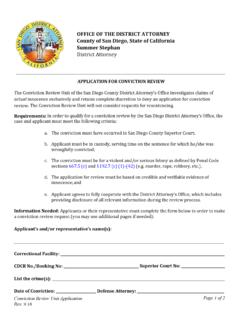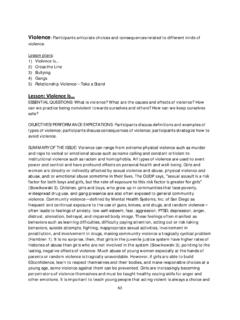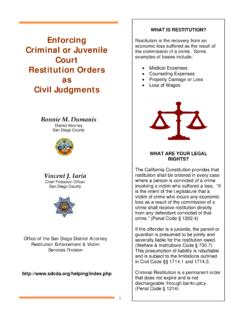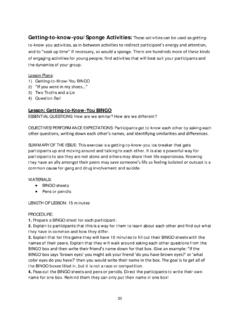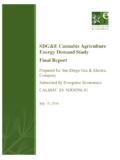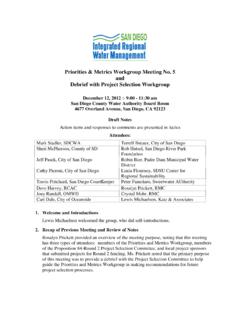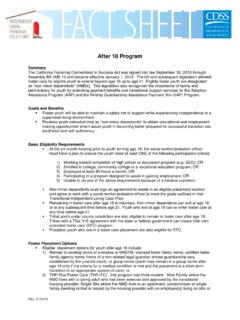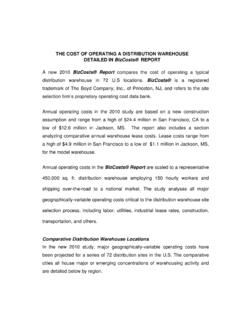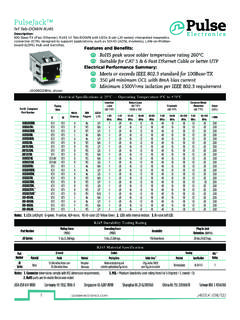Transcription of Creative Arts - San Diego County District Attorney
1 97 Creative arts : Participants explore various Creative endeavors; participants discuss how art can be used as a form of communication, as a means to express thoughts and feelings, and as a medium for social change. While these lessons specifically address the topic of arts and creativity, arts and creativity can be integrated into most lessons in the Girls Only toolkit. Lesson plans: 1) Talent Show 2) Creative arts Ideas Lesson: Talent Show ESSENTIAL QUESTIONS: How can demonstrating personal talents and receiving positive feedback strengthen self-esteem? OBJECTIVES/PERFORMANCE EXPECTATIONS: Promote community amongst Girls Only participants; identify personal talents; practice performing for a group; practice giving and receiving encouraging and positive feedback; practice skills learned in previous lessons.
2 summary OF THE ISSUE: Talent shows provide arenas for people of all ages to demonstrate a skill or talent of their choice. Although talent shows are often competitive and the winner sometimes receives a prize, the goals of this talent show are solely to practice performing, have fun, and encourage positive feedback and therefore it should not be a competition. Young people who receive regular praise and encouragement feel better about themselves and are generally motivated to succeed; a talent show is a fun, engaging way for participants to show off something they are good at and to receive praise for their efforts. MATERIALS: Flyers to promote the talent show Microphone Stereo for music Table for judges Stage area Chairs or seating area for audience Positive feedback posters LENGTH OF LESSON: 2 lesson periods, 45 minutes to 1 hour each PROCEDURE: 1.
3 Prepare by introducing the idea to participants. Explain that the talent show will be a showcase of talents including dancing, singing, poetry, music, and anything else they can think of. The talent show will not be competitive, it will not be about winning or losing, but about showing off something you are proud of. Remind participants they will practice being supportive of each other and encouraging each other. 2. Give participants time to brainstorm about their acts. Advise as necessary. Performing in the talent show should not be required. Provide an alternative for those who do not wish to 98 perform, such as being in charge of music, being the MC/announcer, making programs, or welcoming guests.
4 Performers can work alone, in pairs, or in groups and can be in more than one act. 3. Have participants sign up for their acts and begin to rehearse. Give ample time for participants to rehearse. Suggest that they rehearse outside of Girls Only if possible. Assist as necessary. Prepare music and props as necessary. Set rules regarding appropriate costumes as necessary. 4. Have participants make posters with positive encouragement for the talent show. Sign suggestions: Great job! Awesome! You rock! Excellent performance! You ve got talent! 5. Invite parents/guardians and other community members, as appropriate, to come watch the performance. Give at least a week s notice. 6.
5 On the day of the performance, set up chairs or a seating area for the audience. Set up music and staging area. Have performers sit in a reserved for performers area of the audience. 7. Have audience members and performers hold the posters up during the show. 8. After everyone is seated, welcome the audience to the show. Tell them that every performer has worked very hard on their act and to show how much you enjoy their hard work through applause. Remind them to be a respectful audience and practice giving positive feedback and support. 9. Introduce each act and the performers by name before they come onto the stage. If there is a student acting as the announcer, assist them as necessary.
6 10. Enjoy the talent show! Support the participants! Remember how scary it is to perform in front of people. 11. At the end of the show, invite all performers to the stage to take a final bow. Dismiss the audience. 12. Prepare for a follow up discussion with participants at the next meeting: How did it feel to perform? What went well? What could have been better? What about the talent show made you feel good? What did not make you feel good? What would you do differently next time? Would you perform again? JOURNAL PROMPT: What was your favorite part about performing in the talent show? What did you learn from being part of the talent show? EVALUATION: Did the participants give each other positive feedback?
7 During rehearsals were the participants able to work out disagreements within or amongst groups? Did the talent show go smoothly? RELATED ACTIVITIES: Give each performer a flower following the performance! 99 Lesson: Creative arts Ideas ESSENTIAL QUESTIONS: How can I use creativity and art to have fun, challenge my imagination, communicate a message, or change the world? OBJECTIVES/PERFORMANCE EXPECTATIONS: Participants participate in or create a Creative activity such as poetry, theater, song, music, dance, painting, collages, paper arts , public art, photography, multi-media arts , and various crafts using multiple mediums. summary OF THE ISSUE: Art is a site of Creative expression, self-definition and identification.
8 Art can be broadly defined as expressions of feelings, ideas, values, and perception. Art can include poetry, theater, song, music, dance, painting, collages, paper arts , public art, photography, multi-media arts , and various crafts using multiple mediums. Participation in arts activities enhances girls lives emotionally, socially, and creativity. SchoolArts magazine asserts that through the arts , young people have the chance to express themselves and, fostering creativity in the arts --or anything else--means encouraging students to think for they link arts to their own personal experience (Adams and Hamm 24). The magazine further lists the following as benefits of arts education: the arts empower children to communicate ideas that words and numbers cannot always adequately arts encourage multiple arts teach flexibility in thinking, a mandate for success in a global *and+ the arts teach students to continue searching for meaning and understanding (Stephens 65).
9 The arts have also been used as sites for social change and can send messages to audiences that raise awareness and consciousness, challenge norms, and incite action. Art has been an integral part of feminist activism since the inception of the movement and feminists have notably used film, poetry, performance art, music, paintings, comedy, and, recently, zines, web-based art, and comics, to express politics, making it especially significant for young girls to learn about the arts . Using arts in the classroom is a hands-on approach to instruction and caters to a variety of learning styles including visual, auditory, kinesthetic, and tactile. Young people become engaged and excited about learning when they participate in crafts projects and music activities.
10 Ideas for Creative art activities include: writing poetry, writing fictional stories, drawing a comic strip, learning to play an instrument, singing a song, choreographing a dance, sewing, making a collage from magazine cutouts, painting a picture, painting a mural, sketching a portrait, making a handmade paper card, folding origami, making friendship bracelets, acting in a skit, decorating a shirt or bag, making a photo exhibit, shooting a film, delivering a spoken word performance, or anything you can think of that gets the creativity flowing! Make proper arrangements to include all participants in all Creative activities, being especially attentive to the needs of participants with disabilities.
